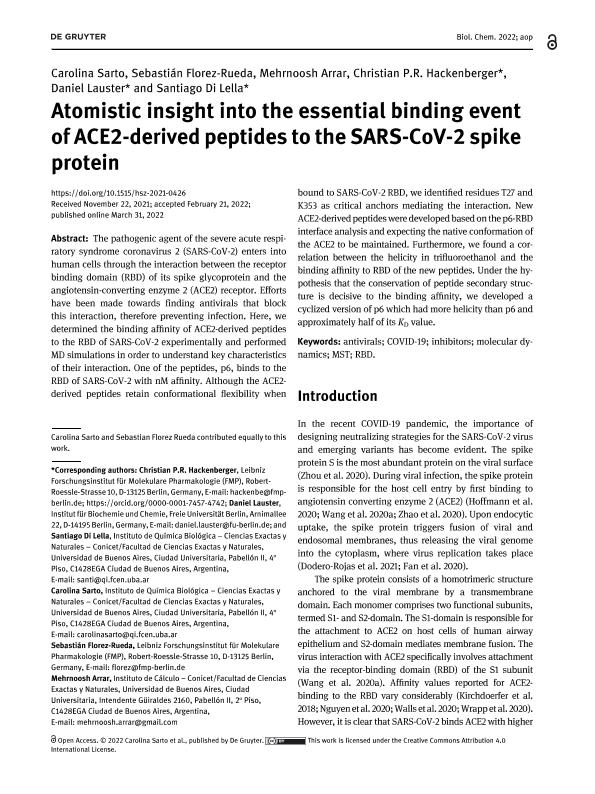Mostrar el registro sencillo del ítem
dc.contributor.author
Sarto, Carolina

dc.contributor.author
Florez Rueda, Sebastián
dc.contributor.author
Arrar, Mehrnoosh

dc.contributor.author
Hackenberger, Christian P. R.
dc.contributor.author
Lauster, Daniel
dc.contributor.author
Di Lella, Santiago

dc.date.available
2023-08-22T15:42:27Z
dc.date.issued
2022-03
dc.identifier.citation
Sarto, Carolina; Florez Rueda, Sebastián; Arrar, Mehrnoosh; Hackenberger, Christian P. R.; Lauster, Daniel; et al.; Atomistic insight into the essential binding event of ACE2-derived peptides to the SARS-CoV-2 spike protein; De Gruyter; Biological Chemistry; 403; 5-6; 3-2022; 615-624
dc.identifier.issn
1431-6730
dc.identifier.uri
http://hdl.handle.net/11336/208903
dc.description.abstract
The pathogenic agent of the severe acute respiratory syndrome coronavirus 2 (SARS-CoV-2) enters into human cells through the interaction between the receptor binding domain (RBD) of its spike glycoprotein and the angiotensin-converting enzyme 2 (ACE2) receptor. Efforts have been made towards finding antivirals that block this interaction, therefore preventing infection. Here, we determined the binding affinity of ACE2-derived peptides to the RBD of SARS-CoV-2 experimentally and performed MD simulations in order to understand key characteristics of their interaction. One of the peptides, p6, binds to the RBD of SARS-CoV-2 with nM affinity. Although the ACE2-derived peptides retain conformational flexibility when bound to SARS-CoV-2 RBD, we identified residues T27 and K353 as critical anchors mediating the interaction. New ACE2-derived peptides were developed based on the p6-RBD interface analysis and expecting the native conformation of the ACE2 to be maintained. Furthermore, we found a correlation between the helicity in trifluoroethanol and the binding affinity to RBD of the new peptides. Under the hypothesis that the conservation of peptide secondary structure is decisive to the binding affinity, we developed a cyclized version of p6 which had more helicity than p6 and approximately half of its K D value.
dc.format
application/pdf
dc.language.iso
eng
dc.publisher
De Gruyter

dc.rights
info:eu-repo/semantics/openAccess
dc.rights.uri
https://creativecommons.org/licenses/by/2.5/ar/
dc.subject
ANTIVIRALS
dc.subject
COVID-19
dc.subject
INHIBITORS
dc.subject
MOLECULAR DYNAMICS
dc.subject
MST
dc.subject
RBD
dc.subject.classification
Otras Ciencias Químicas

dc.subject.classification
Ciencias Químicas

dc.subject.classification
CIENCIAS NATURALES Y EXACTAS

dc.title
Atomistic insight into the essential binding event of ACE2-derived peptides to the SARS-CoV-2 spike protein
dc.type
info:eu-repo/semantics/article
dc.type
info:ar-repo/semantics/artículo
dc.type
info:eu-repo/semantics/publishedVersion
dc.date.updated
2023-07-07T22:46:43Z
dc.journal.volume
403
dc.journal.number
5-6
dc.journal.pagination
615-624
dc.journal.pais
Alemania

dc.journal.ciudad
Berlin
dc.description.fil
Fil: Sarto, Carolina. Consejo Nacional de Investigaciones Científicas y Técnicas. Oficina de Coordinación Administrativa Ciudad Universitaria. Instituto de Química Biológica de la Facultad de Ciencias Exactas y Naturales. Universidad de Buenos Aires. Facultad de Ciencias Exactas y Naturales. Instituto de Química Biológica de la Facultad de Ciencias Exactas y Naturales; Argentina
dc.description.fil
Fil: Florez Rueda, Sebastián. Leibniz Forschungsinstitut Für Molekulare Pharmakologie; Alemania
dc.description.fil
Fil: Arrar, Mehrnoosh. Universidad de Buenos Aires. Facultad de Ciencias Exactas y Naturales. Instituto de Calculo. - Consejo Nacional de Investigaciones Científicas y Técnicas. Oficina de Coordinación Administrativa Ciudad Universitaria. Instituto de Calculo; Argentina
dc.description.fil
Fil: Hackenberger, Christian P. R.. Leibniz Forschungsinstitut Für Molekulare Pharmakologie; Alemania
dc.description.fil
Fil: Lauster, Daniel. Freie Universität Berlin; Alemania
dc.description.fil
Fil: Di Lella, Santiago. Consejo Nacional de Investigaciones Científicas y Técnicas. Oficina de Coordinación Administrativa Ciudad Universitaria. Instituto de Química Biológica de la Facultad de Ciencias Exactas y Naturales. Universidad de Buenos Aires. Facultad de Ciencias Exactas y Naturales. Instituto de Química Biológica de la Facultad de Ciencias Exactas y Naturales; Argentina
dc.journal.title
Biological Chemistry

dc.relation.alternativeid
info:eu-repo/semantics/altIdentifier/url/https://www.degruyter.com/document/doi/10.1515/hsz-2021-0426/html
dc.relation.alternativeid
info:eu-repo/semantics/altIdentifier/doi/http://dx.doi.org/10.1515/hsz-2021-0426
Archivos asociados
